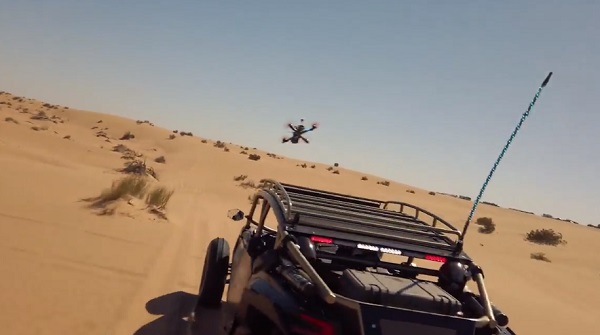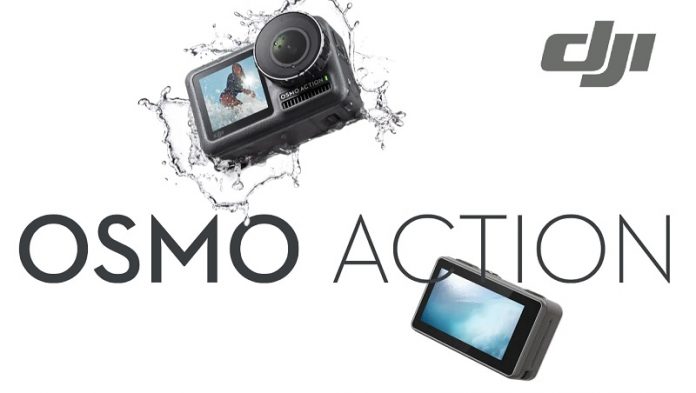A few days ago, DJI – the market leader in drone technology – officially revealed their first GoPro alike rugged action camera. Let’s find out if drone pilots should switch to Osmo Action or stay with their Hero 7.
Smartphone cameras are pretty incredible these days but it is are very hard to install them on drones, especially if you want to use them together with mechanical gimbals. For a long time, GoPro was the favorite brand of most FPV drone pilots. In addition to its excellent image quality, it has a wide range of mounting accessories.
In 2015, DJI began putting their motorized image-stabilization technology into hand-held camera gimbals. While it was well-received by vloggers, being large and heavy, drone pilots had no interest in it. Later, they announced a much smaller handheld gimbal camera called Osmo Pocket. Despite its incredibly small size, it still could not be used successfully on drones. Let’s be fair, handheld gimbals are good for vlogging and travailing, but surely not for extreme conditions like drone mounting or water-sport activities.

DJI Osmo Action – Unleash Your Other Side
Lately, many action camera manufacturers announced their own drones. GoPro has the Karma, and Xiaomi has the FiMI X8SE. DJI’s response was inevitable, they had to enter into this world too!
At first glance, the Osmo Action beets are the most action camera on the market. It features a rugged design and dual-display system for selfie enthusiasts. Without housing, the Osmo Action can travel 11m/36ft safely underwater (one meter deeper than the GP7). Thanks to its versatile battery, it is certified to be used in extremely cold environments with temperatures as low as -10℃.
Osmo Action vs GoPro Hero 7
As you can see in the comparison table below, these two action cameras share similar specs. Both adopt near-identical image sensors that can shoot 4K video at up to 60 frames per second. While DJI names their electronic image stabilization “RockSteady”, GoPro is call it “HyperSmooth”. Anyway, you will need to use a mechanical gimbal for smooth videos. Due to the dual-display approach, the Osmo Action is slightly heavier than its contender.
| Osmo Action | GoPro Hero 7 Black | |
| Dimensions | 65 × 42 × 35 mm | 62.3 x 44.9 x 28.3 mm |
| Weight | 124 grams | 116 grams |
| Waterproofing | 11 meters | 10 meters |
| Image sensor | 1/2.3-inch CMOS 12-megapixels | 1/2.3-inch CMOS 12-megapixels |
| Live-view display | Front+Rear | Rear |
| Max video resolution/frame rate | 4K/60fps or 1080p/240fps | 4K/60fps or 1080p/240fps |
| Max video bit-rate | 100Mbs | 78Mbps |
| HDR | Yes (EIS disabled) | No |
| Video stabilization | Electronic (RockSteady) | Electronic (HyperSmooth) |
| Slo-mo speed | 8x | 8x |
| Livestreaming | No | Yes |
| Special modes | Timelapse, Hyperlapse, Mimo My Stories | Timelapse, TimeWarp, QuickStories |
| Price | $349 | $399.99 |
Similar to the Hero 7, it has two microphones (one on the top, another on the side), which can provide pretty enjoyable audio. Anyway, DJI says that for superior audio quality, the Osmo Action will receive an external microphone.
DJI Osmo Action offers a comparable range of trick shots to its biggest rival, including slow-motion (1080p@240fps), time-lapse, and even voice command. Furthermore, it has 100Mbps recording bit-rate and HDR video mode.

Conclusions
IMHO, in case you already own a GoPro camera, there is no real reason to switch. On the other hand, if you are looking for your first drone camera, the Osmo Action is a good choice due to its more friendly price tag. It does almost the same thing as the $ 50 more expensive H7.


The 63 minute running time is pretty disappointing!
DJI already has couple of cool drones, why to use their camera on an other branded quadcopter????
I will skip over the Osmo Action, but at least GoPro already started to drop their prices…….
Audio adapter from Osmo Pocket also works with the new Osmo Action, so yo don’t need to wait